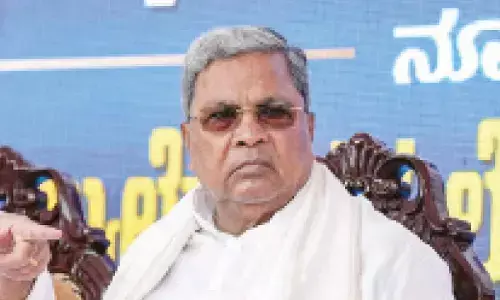KCR could have done far far better

What is really worrying is the off budget borrowing of Rs 1,27,208 crore which does not confirm to FRBM rules and is taken in a clandestine way from financial institutions, showing streams of income which never were there nor are going to come
It is now becoming a norm for any new government taking over, to come out with a white paper on a number of issues, blaming the previous government for all the ills, and promise to deliver better. The white paper released by the new Telangana government on state finances is one such.
KCR when he came to power in 2014 had a golden opportunity of turning Telangana into a model state in India. It was a small compact state with tremendous emotional integration. It has a major metropolis Hyderabad already on the national and world map as a city of destination, and building on that foundation should have been an easy task. Did he squander away this golden opportunity? Before we pass a judgement let us have a look at what the white paper says about the state finances.
The first part of the white paper explains the gap between the budgeted estimates and the actual expenditure and compares the same with that of other States. Though this is an important parameter, it may not be that significant in assessing the 10-year rule of KCR. This gap started widening even from the time of United Andhra Pradesh when successive Chief Ministers started taking credit for big budget outlays, not supported by the incoming revenues. Budget of Rs 1 lakh crore and later Rs 2 lakh crore has become a statement of political pride for the Chief Ministers in office.
The second part also may not particularly be relevant in assessing the rule of KCR. It seems to have been made a part of the white paper just to show that Telangana was not discriminated against in United Andhra Pradesh and the Congress rule right from 1956 had done well, resulting in a number of Central institutions coming to Hyderabad and nearby places.
The next part deals with the revenue of the state and wide variation from year on year. The overall revenue to GSDP ratio has come down between 2015-16, 2018-19 and the ratio is also low compared to other states. This just highlights the potential for tapping additional revenues to shore up the state finances, but may not be a big reflection of any bad governance by the previous regime.
Now comes the most important part of the white paper – the debt position of the state. The debt is divided into three portions: 1. Debt incurred as per FRBM norms - Rs 3,89,673 crore; 2. SPV (special purpose vehicle) loans to be serviced by the government - Rs1,27,208 crore; and 3. Loans taken by the SPVs or corporations to be served out of their own revenues with or without government guarantees which cannot be counted as part of the overall state debt, since servicing them is not the responsibility of the state government.
Hence, the overall state debt is Rs 5,16,881 crore not Rs 6,71,757 crore as the white paper has tried to project. However, the worrying factor is steep increase in debt-to-GDP ratio even when we take the debt at Rs 5,16,881 crore. The ratio which was at 15.7% in 2015-16 has gone up to 36.9% including the off budget borrowings which have to be serviced by the state government.
Excluding the off budget borrowings, even the borrowings as per FRBM norms are also quite high at 27.8% of debt-to-GDP ratio. But these are debts incurred with Government of India’s permission, following FRBM norms with RBI intermediation. FRBM norms were relaxed during the Covid times, facilitating higher borrowings by the states and it was not specific to Telangana.
What is really worrying is the off budget borrowing of Rs 1,27,208 crore which does not confirm to FRBM rules and is taken in a clandestine way from financial institutions, showing streams of income which never were there nor are going to come. No sensible banker will believe such streams of income and lend loans. I wish the white paper publicly stated which financial institutions lent to this state government on such dubious claims. I am sure no private financer would do that. It can only be a public sector bank where the management feels they can do anything like this and get away with it with right political connections.
The new regime in Telangana should formally file a complaint with RBI and Government of India for a detailed inquiry so that in future public sector banking managements should think twice before embarking on such misadventure.
And where have this off budget borrowings gone? Of course, a bulk of them went to Kaleshwaram project with an outstanding loan of 74,590 crore and drinking water supply corporation with an outstanding loan of Rs 20,200 crore. Mission Kakatiya and Mission Bhagiratha: Whatever was spent on rural water supply scheme is very well spent. Ensuring portable drinking water should have been the priority for any government and it was good that it was finally achieved during KCR regime.
Given the topography of Telangana, lifting of water to irrigate is inevitable, but was Kaleshwaram the best option? Did the engineers and professionals have a free hand in designing the project? Or some other interests dominated the designing resulting in today’s problems? This is what needs to be enquired into and answered by the present regime.
Another aspect of concern highlighted by the white paper is consistent neglect of education and medical and health in the last 10 years where Telangana expenditure on both these sectors is very low compared to all other states. Even after such huge pile-up of debt, if the state failed to take care of these two important social sectors, it shows the lopsided priorities of the previous regime.
The indicators of fiscal and revenue deficit are not bad. High level of ways and means borrowing reflects on budgeting of expenditure far beyond the resources.
Where does the state stand comparatively with reference to debt-to-GDP ratio? Of course, we have a state like Punjab with a debt-to-GDP ratio of 46.8%. Telangana is in the good company of Andhra Pradesh, Bihar, West Bengal with a debt-to-GDP ratio of 33% to 37%. Given the revenue surplus position at the time of bifurcation of the state and low GDP-to-debt ratio of 15.7%, Telangana should never have been in this position but for huge debts incurred by KCR. Part of it has been put to great use finding a permanent solution to drinking water problems in villages through Mission Bhagiratha. Instead of drilling borewell after borewell with doubtful water source, it is good that a permanent solution to drinking water supply is found. Mission Kakatiya could have been managed far better and there was no need at all to have neglected education and medical and health.
Overall, KCR government has not done all that badly though he could have done far far better.
(Writer is a former Chief Secretary of Andhra Pradesh)




















